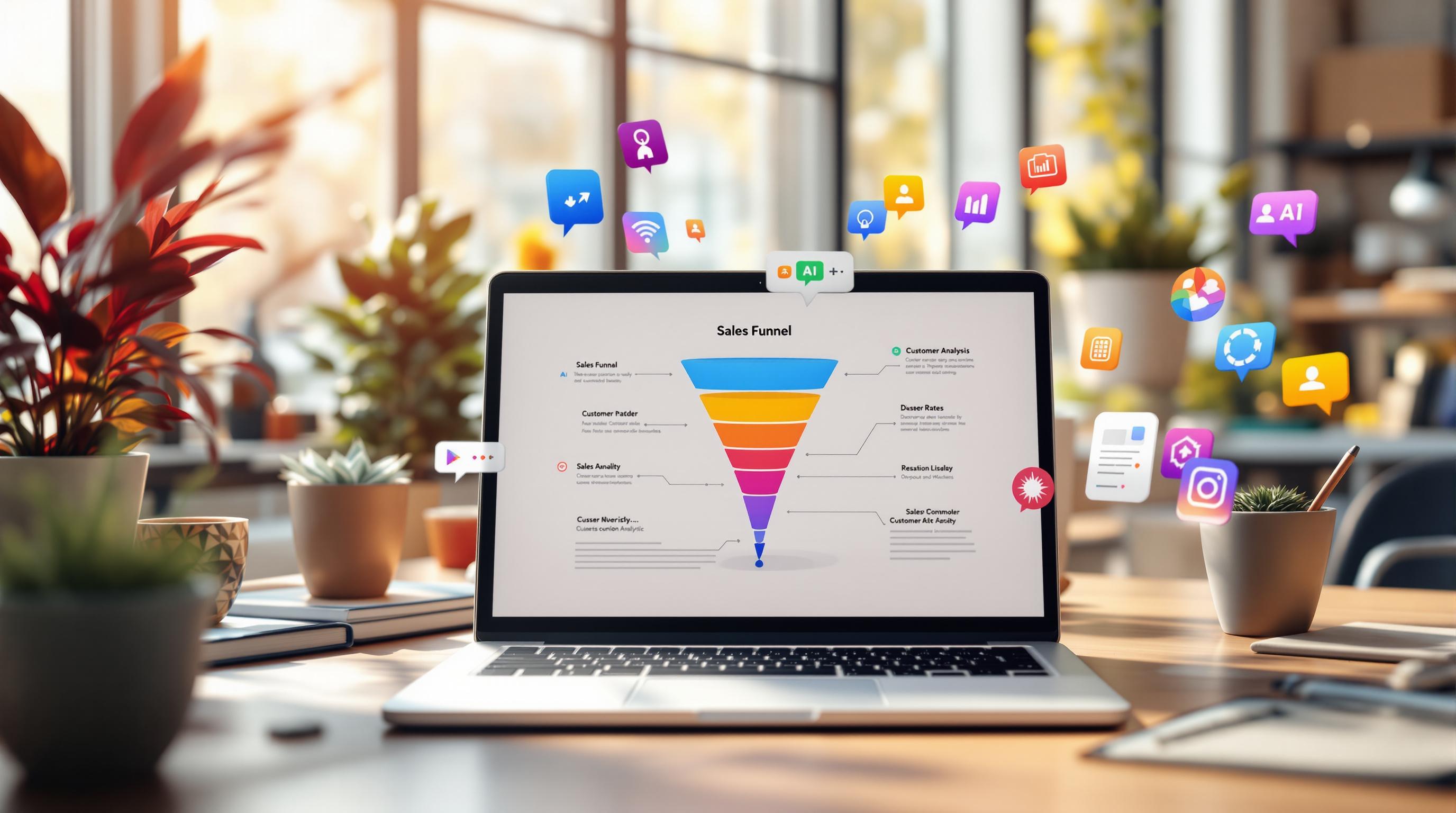AI is changing how businesses find and prioritize leads. With tools like HubSpot, Drift, and Clearbit, companies can now:
- Score leads instantly using predictive analytics.
- Engage customers in real time with behavior-triggered actions.
- Automate tasks like email collection and lead qualification.
Why It Matters:
- Traditional methods are slow and manual.
- AI offers immediate insights, personalized outreach, and automated workflows.
| Key Difference | Traditional | AI-Powered |
|---|---|---|
| Response Time | Hours to days | Instant |
| Lead Scoring | Manual | Automated |
| Customer Engagement | Scheduled follow-ups | Real-time interactions |
By combining tools like Customers.ai, ZoomInfo, and Email Extractor Tool, businesses can improve conversion rates, save time, and focus on closing deals.
Want to know how to implement these tools? Start by reviewing your current process, choose the right AI platforms, and integrate them seamlessly into your systems.
Benefits of Real-Time AI Analytics
Using Predictive Data to Target Leads
Real-time AI analytics transforms how businesses identify and prioritize leads. By analyzing both historical and live customer behavior, these tools predict conversion likelihood with advanced pattern recognition. For instance, HubSpot's AI-driven lead scoring uses predictive analytics to rank prospects based on their potential to convert, helping businesses focus on the most promising opportunities [1][3]. This technology empowers teams to deliver personalized and timely customer interactions.
Personalized Customer Engagement
AI tools excel at tailoring communication to match live customer actions. Platforms like Lyne AI and Customers.ai create messages that align with individual preferences, boosting engagement rates [2][4].
Here’s how AI-powered engagement compares to traditional methods:
| Aspect | Traditional Approach | AI-Powered Approach |
|---|---|---|
| Response Time | Scheduled follow-ups | Instant, behavior-triggered |
| Message Customization | Template-based | Dynamic, context-aware |
| Interaction Scale | Limited by team size | Unlimited concurrent engagement |
| Lead Qualification | Manual assessment | Automated, real-time evaluation |
These AI tools not only improve engagement but also ensure that interactions are delivered efficiently, no matter the scale.
Streamlining Tasks with Automation
Beyond targeting and engagement, real-time AI analytics significantly boosts efficiency by automating routine tasks. Tools like Leadfeeder and ZoomInfo automatically enrich lead profiles and detect intent signals, eliminating the need for manual effort [1][3]. Meanwhile, Drift's AI chatbots handle multiple website visitors simultaneously, qualifying leads, updating CRM records, and freeing up sales teams to concentrate on closing deals [1][3].
For email lead generation, tools like Email Extractor Tool simplify the process by automating the identification and collection of contact information, making it easier to build targeted outreach campaigns [Email Extractor Tool].
Tools and Methods for Real-Time AI Analytics
AI Tools for Email Extraction
The Email Extractor Tool simplifies collecting email addresses by automating the process. It supports bulk extraction, processes data instantly, and organizes it for easy export. This makes it a go-to solution for streamlining lead generation workflows. The Chrome extension works seamlessly with existing systems, offering features like CRM integration and automated workflows to manage contacts efficiently.
| Feature Category | Capabilities |
|---|---|
| Data Collection | Automated email detection, Bulk extraction, Real-time processing |
| Export Options | CSV download, TXT format, Structured data organization |
| Integration | Chrome extension, CRM compatibility, Automation workflows |
| Support Level | Priority email support, Premium assistance for enterprise users |
In addition to email collection, these tools assist in lead scoring and provide insights to help prioritize potential customers.
AI for Lead Scoring and Insights
HubSpot's AI lead scoring tool evaluates potential customers by analyzing their behavior and engagement patterns. This helps businesses focus on leads with the highest chance of converting. The tool's real-time scoring feature ensures quick responses to high-intent actions, such as notifying sales teams or initiating outreach. By combining lead scoring with customer journey mapping, businesses can gain a deeper understanding of their audience's behavior.
Mapping the Customer Journey with AI
AI platforms like Drift analyze customer interactions to map out their journey, pinpoint key decision-making moments, and refine sales strategies. These tools continuously learn from data, enabling businesses to:
- Identify the best timing for conversions
- Understand how different customer segments navigate the sales funnel
For example, Customers.ai uses machine learning to fine-tune marketing strategies and boost conversion rates [4]. Its algorithms adjust to evolving customer behaviors, ensuring lead generation efforts stay effective and relevant.
These mapping tools integrate seamlessly with email extraction and lead scoring systems, creating a dynamic ecosystem that adapts to customer needs and behaviors in real-time.
sbb-itb-8abf799
Steps to Implement Real-Time AI Analytics
Reviewing Current Lead Generation Methods
Before diving into AI analytics, it's important for businesses to evaluate their current lead generation processes. This means looking at conversion rates, engagement metrics, and any manual inefficiencies. The goal? Pinpoint the areas where AI can make a real difference. Once these gaps are clear, the next move is choosing AI tools that fit your business needs.
| Assessment Area | Metrics | AI Solutions |
|---|---|---|
| Lead Scoring | Conversion accuracy rates | Predictive analytics models |
| Data Collection | Time spent on manual tasks | AI-powered automation tools |
| Customer Engagement | Response times and satisfaction | AI chatbots and automation |
| Lead Quality | Sales qualification rates | Machine learning scoring |
Choosing the Right AI Tools
Finding the best AI tools means aligning them with your specific business goals and systems. For example, HubSpot offers a CRM that integrates smoothly and supports customized workflows, making it a popular choice for businesses adopting AI [1]. If email-based lead generation is your focus, the Email Extractor Tool is another option, offering automated capabilities with flexible plans for different data needs.
Key factors to consider when evaluating AI tools include:
- Compatibility with your current tech setup
- Scalability to manage increasing data needs
- Real-time processing to ensure fast insights
- Cost-effectiveness based on your expected ROI
Integrating AI with Existing Systems
Real-time AI tools work best when they blend effortlessly with your existing systems to deliver instant insights and actions. A great example is Customers.ai, which combines AI chatbots with marketing automation tools to simplify lead generation processes [4].
To ensure smooth integration:
- Start with a pilot program targeting one area to test effectiveness.
- Set clear metrics to measure success.
- Provide thorough training to your team on AI-powered workflows.
- Regularly monitor performance and make adjustments as needed.
"AI integration success depends on choosing tools that complement existing workflows while providing clear pathways for scaling operations", according to a recent study on AI in lead generation [1][3].
Once AI tools are fully integrated, businesses can refine processes and scale their lead generation efforts effectively.
Summary and Final Thoughts
Key Advantages of Real-Time AI Analytics
Real-time AI analytics equips businesses with tools to predict trends, engage customers on a personal level, and automate processes. These features play a major role in boosting lead generation and streamlining operations [1]. Here's a breakdown of how these benefits translate into tangible business results:
| Advantage | Impact | Business Outcome |
|---|---|---|
| Predictive Analytics | More accurate lead scoring | Higher conversion rates |
| Real-time Personalization | Stronger customer engagement | Increased response rates |
| Workflow Automation | Fewer manual tasks | Better resource use |
These outcomes highlight the importance of choosing the right AI tools to unlock the full potential of real-time analytics.
Picking the Right Tools to Succeed
Finding AI tools that align with your business goals is crucial. Look for platforms that integrate easily, scale with your needs, and provide dependable data accuracy to ensure a strong return on investment. For example, ZoomInfo and Clearbit enhance B2B contact data with real-time intent signals, while the Email Extractor Tool focuses on automating email discovery for lead generation [2].



